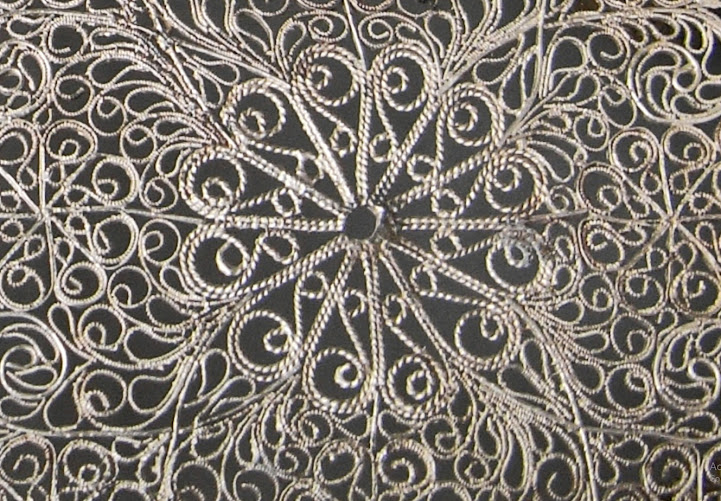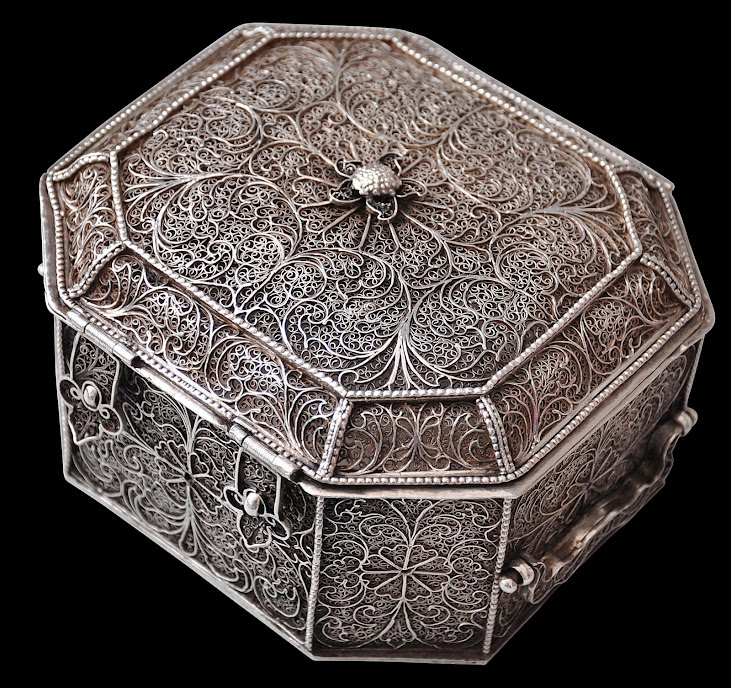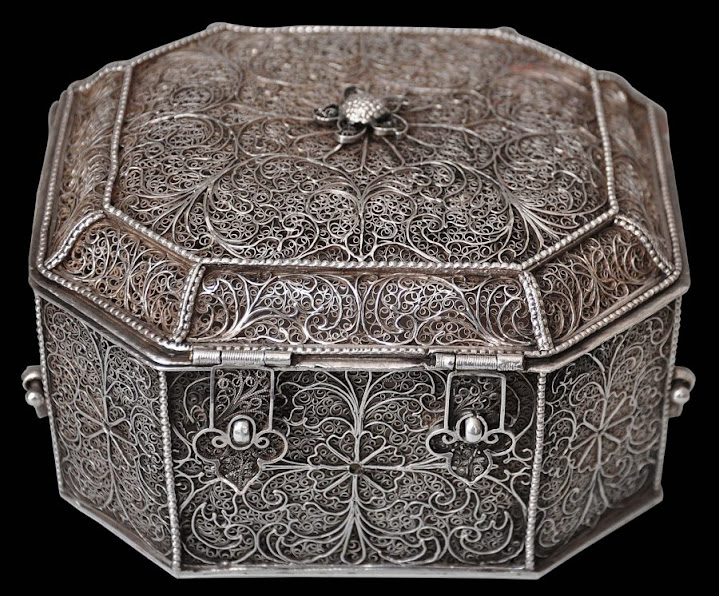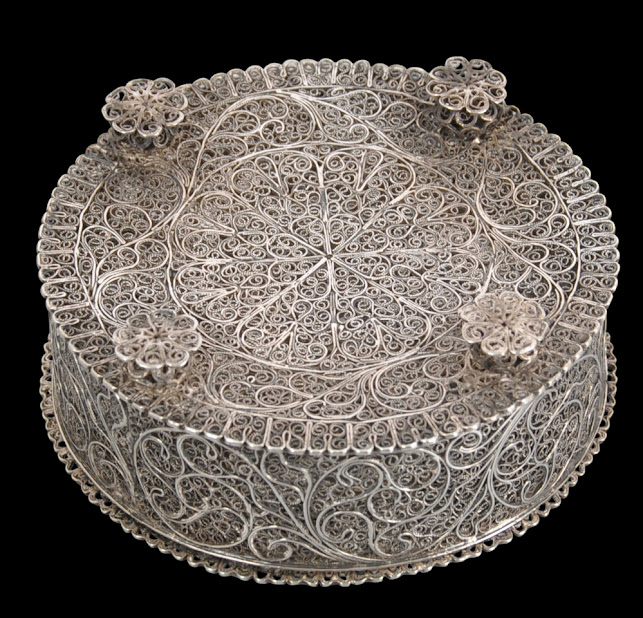Post Updated 21 October 2023.
The Dullaert Art and Antiques 17th Century Shallow Domed Top Silver Filigree Casket or Knottekistje.
(The Traditional Dutch Wedding Casket).
and several possibly related caskets.
In these caskets the twisted wire infills are set back slightly from the arabesque rectangular section framing - unlike those where the infills are flush with the framing.
It might, at some point in the future, be instructive to compare the different types of hinges employed in the various caskets.
The Khalili casket uses a type of hinge cover decoration which appears on several other caskets.
I think that these caskets might form a sub type but the usual lack of any provenance doesn't help.
10.5 x 8 x 6.5 cms
.............................
The British Museum Silver Filigree Casket.
I believe closely related to the Dullaerts casket above.
The tulip finial is perhaps instructive - Dutch?
The rope twist elements making up the frame are very unusual in this sort of casket.
15.2 x 7.7 cms.
Previously with Messrs Spink & Sons Ltd described by them as circa 1665.
Hall Grundy Collection. 1974.
___________
An Octagonal Casket formerly with London Dealer Michael Backman.
Length: 12.5cm height: 7cm, width: 11cms.
The little embossed / repousse boss on the flower in the centre of the lid appears occasionally on other (German) pieces - The Silver Gilt, Silver Filigree and Boulle work Toilet Mirror is an example. I will be posting on this mirror in due course.
I am very grateful to Michael Backman for allowing me to use his photographs.
--------------------
Fries Museum Silver Filigree Casket.
The Museum website say Tea Drum / Caddy maker Jan Buysen, Amsterdam.
I think late 17th / early 18th Century.
I suspect that it has an inner silver liner with the mark of Jan Buysen.
Jan Buysen 1747 - 1813 - working in Amsterdam from 1777.
Width: 10.9 cm , height: 13.5 cm , length: 16.8 cms.
Unfortunately only a very low resolution image from the Fries Museum website.
Since posting this object I have received some better photographs
_______________
Collection City of Genoa.
Height 11.8 cms. Width 20.2 cms. Depth 15 cms.
Lined in white satin with handles on the sides.
In 1848, as reported in the study on Santa Maria di
Nazareth (Tomaini P./ Rossignotti A. 1975, p. 254) the institution had to resort
to a loan to pay for the new Collegiate organ , and pledge "..a small
silver box worked with grain thread containing a small chalice with its paten
weighing four and a half pounds". In 1852, the loan covered, the objects
returned to the Collegiate.
The casket contains a silver chalice with paten
(see entries nos. 14434 and 14434A).
_________________
Very fine Round Silver Filigree Box.
With Silver Gilt Monogram incorporated into the lid.
Is the glass Rock Crystal?
Previously with London dealer Michael Backman.
Diameter: 12cm, height: 5.3cm.
The
crowned "V", was used 1814-1893 as a tax mark applied to all imported,
unmarked and invalid marked objects of foreign, national and unknown origin. It does not necessarily mean that the object was imported! It is also not a guarantee of quality. Very little Silver Filigree is marked due to the difficulty of the process.
This very fine box is included in this post because of the construction - the small, finer filigree double twisted wire elements are set back from the surface formed by the larger rectangular section elements, as in the caskets illustrated above.
The filigree bun feet suggest an early date.
It would be useful to know whose monogram appears on the lid?
There are several other silver filigree objects with monograms incorporated into the designs -, the furniture art Rosenborg Castle, Denmark, the writing box of William III now in the Hermitage, St Petersburg and a Gold filigree embellished Casket currently (May 2023) with ALJ Antiques, London.
Michael Backman says possibly Sumatra Batavia - currently I am not so sure.
Refs from Michael Backman.
As ever I am very grateful to Michael Backman etc etc.
Haags Gemeentemuseum, V.O.C. – Zilver: Zilver uit de periode
van de Verenigde Oostinische Compagnie 17de en 18de eeuw, 1983.
Piotrovsky, M. et al, Silver: Wonders from the East –
Filigree of the Tsars, Lund Humphries/Hermitage Amsterdam, 2006.
(whilst attempting to give an overview of silver filigree objects in the 178th and 18th century this work requires some serious revisions}.
Tchakaloff, T.N. et al, La Route des Indes – Les Indes et
L’Europe: Echanges Artistiques et Heritage Commun 1650-1850, Somagy Editions
d’Art, 1998.
Voskuil-Groenewegen, S.M. et al, Zilver uit de tijd van de
Verenigde Oostindische Compagnie, Waanders Uitgevers, 1998.
Zandvlieyt, K. et al, The Dutch Encounter with
Asia 1600-1950, Rijksmuseum Amsterdam, 2002.
___________________
For Comparison.
A Silver Filigree casket sold by Stockholms Auctionverk.
This type of hinge appear on other Scandinavian boxes so I suspect that this casket is Scandinavian,
but it is dangerous to make assumptions.
This is another casket with the double twisted silver wire inserts set back from the main rectangular wire elements.
It has a mark in the middle of the base plate. Three Crowns and the letter S.
I have as yet not found any feet like these on other caskets.I suspect that they are replacements.
_______________________
A Small Silver Filigree Casket in the Bayerisches National Museum.
They suggest Naples! So far I have not discovered any evidence of silver filigree caskets made in Italy
The highest resolution photograph available.
H. 6,1 cm, B. 8,4 cm, T. 4,8 cm
_______________________________
The casket pictured on the right is in a Portuguese Collection.
Compare the right hand side casket with the Dulleart Casket above.
The casket on the left appears to be related to the Dresden Green Vault Casket and the Khalili casket.
See my previous posts.







































No comments:
Post a Comment